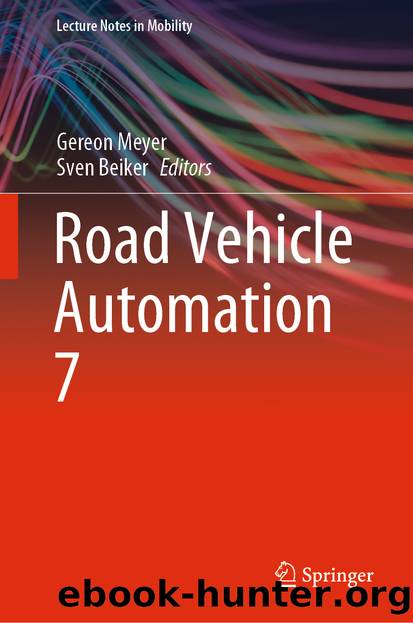Road Vehicle Automation 7 by Unknown

Author:Unknown
Language: eng
Format: epub
ISBN: 9783030528409
Publisher: Springer International Publishing
4 Conclusions
The automation of vehicles is going to change urban life tremendously in the future. It promises an accident-free traffic, optimized traffic flow, and inclusive mobility services. To understand how the German population is feeling about AVs, a representative survey was conducted, which was further compared to scientific and professional expert knowledge in a technical assessment. A central outcome was, that the population is underestimating the potentials of AVs compared to the current opinion in the scientific community. Furthermore, differences in the answers were found that are connected to sociodemographic features of the interviewed group, with females in general being more skeptical towards AVs and their potential. At the same time, those questioned between the ages of 18 to 29 were more open to the new technology, and further assessed the potential of AVs more positively. The older the interviewed persons were, the more critical they were. Other sociodemographic features like the educational level or whether the person lives in rural or urban environments did not correlate to their answers, though. The only question where less deviations between survey respondents and expert knowledge were visible is the question about cyber-security. In general, it is possible that the poll showed a general skepticism towards robotic technologies and not specifically towards AVs. To find that out, further research would be needed, while surely more efforts need to be placed in creating public awareness of the pros and cons of AVs.
It should be noted that the study was conducted in 2019 before the beginning of the COVID-19 crisis. During the pandemic, the worldwide mobility demand changed significantly, with a massive drop in passenger numbers in public transportation systems and shared cars. In sight of these circumstances, it is questionable, whether the survey results would still be the same, today. It is self-evident that mass transportation systems are used less, because it is hardly possible to keep the safety distance in a confined space. Furthermore, there are concerns about the cleanliness of vehicles. As an alternative, the usage of bikes and private cars are increasing. In many cities, roads have been transformed into pop-up pedestrian zones or bike lanes, such that those using the soft modes can keep distance from one another. During the pandemic, a scenario of individuals using small and shared self-driving vehicles instead of public transport may appear the most appealing. A reduction of the usage of car and ride sharing, as well as taxis and other mobility services is noticeable, though. An explanation might be that the population has doubts, whether the vehicles are disinfected properly. So, self-sanitizing capabilities might be a very relevant feature of AVs in the future. It should be considered, though, that overall mobility has shrunk by up to 40% temporarily during the pandemic, because people worked from home, schools and shops were closed, and private meetings were prohibited, all affecting any kind of transportation service. Hence, it is difficult to derive a clear change in the survey results from the behavior during the pandemic. While
Download
This site does not store any files on its server. We only index and link to content provided by other sites. Please contact the content providers to delete copyright contents if any and email us, we'll remove relevant links or contents immediately.
International Integration of the Brazilian Economy by Elias C. Grivoyannis(86633)
The Radium Girls by Kate Moore(11877)
Turbulence by E. J. Noyes(7901)
Nudge - Improving Decisions about Health, Wealth, and Happiness by Thaler Sunstein(7470)
The Black Swan by Nassim Nicholas Taleb(6954)
Rich Dad Poor Dad by Robert T. Kiyosaki(6324)
Pioneering Portfolio Management by David F. Swensen(6175)
Man-made Catastrophes and Risk Information Concealment by Dmitry Chernov & Didier Sornette(5883)
Zero to One by Peter Thiel(5643)
Secrecy World by Jake Bernstein(4599)
Millionaire: The Philanderer, Gambler, and Duelist Who Invented Modern Finance by Janet Gleeson(4307)
Skin in the Game by Nassim Nicholas Taleb(4128)
The Age of Surveillance Capitalism by Shoshana Zuboff(4126)
The Money Culture by Michael Lewis(4033)
Bullshit Jobs by David Graeber(4001)
Skin in the Game: Hidden Asymmetries in Daily Life by Nassim Nicholas Taleb(3873)
The Dhandho Investor by Mohnish Pabrai(3642)
The Wisdom of Finance by Mihir Desai(3612)
Blockchain Basics by Daniel Drescher(3435)
